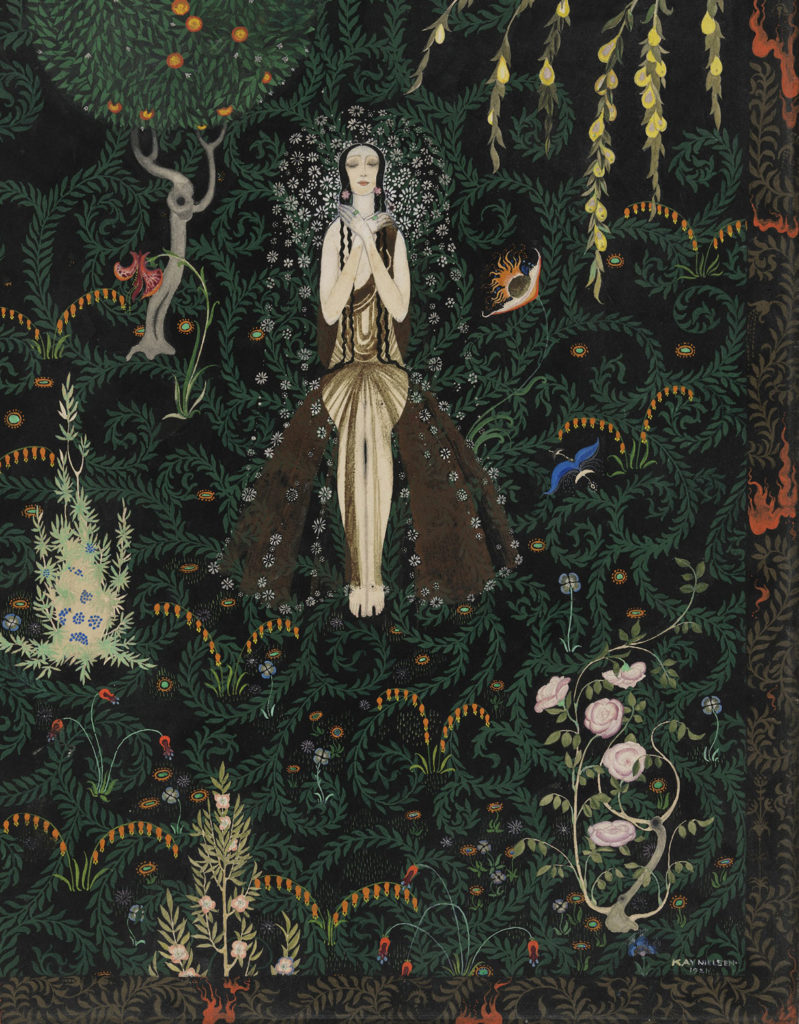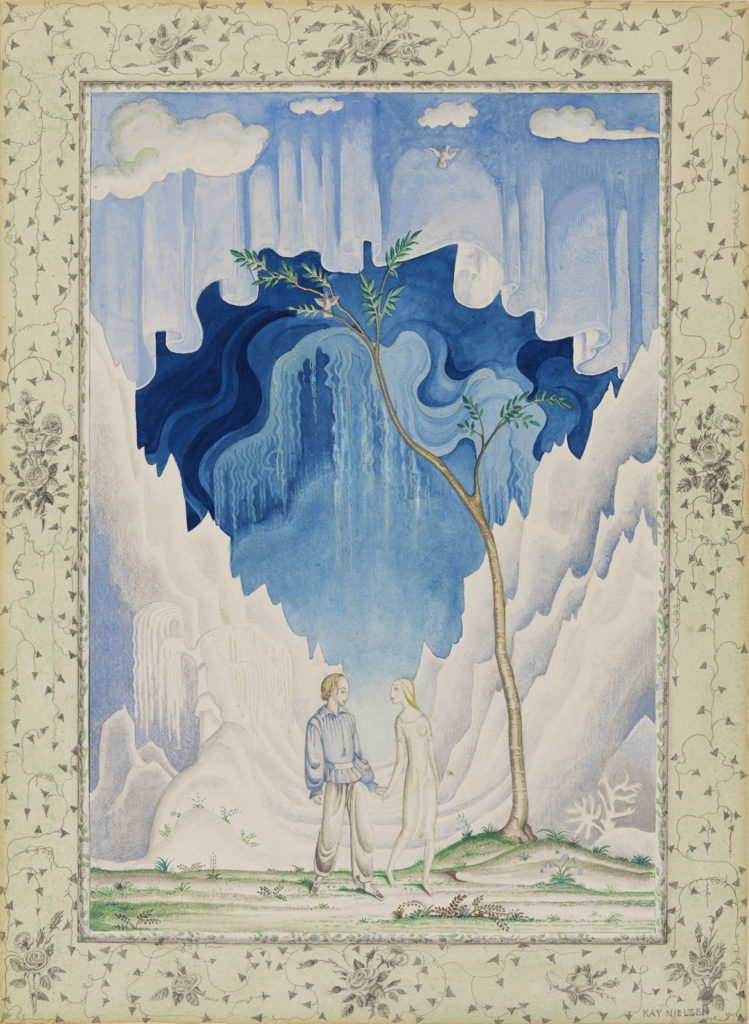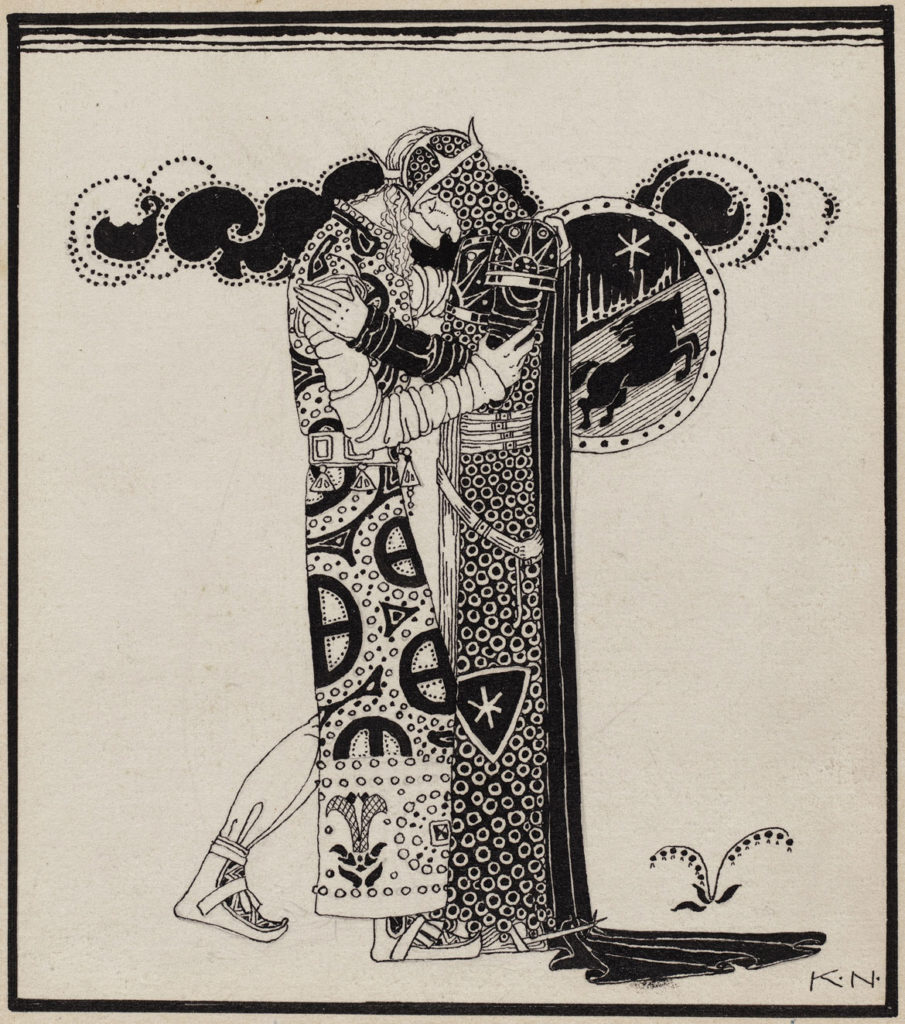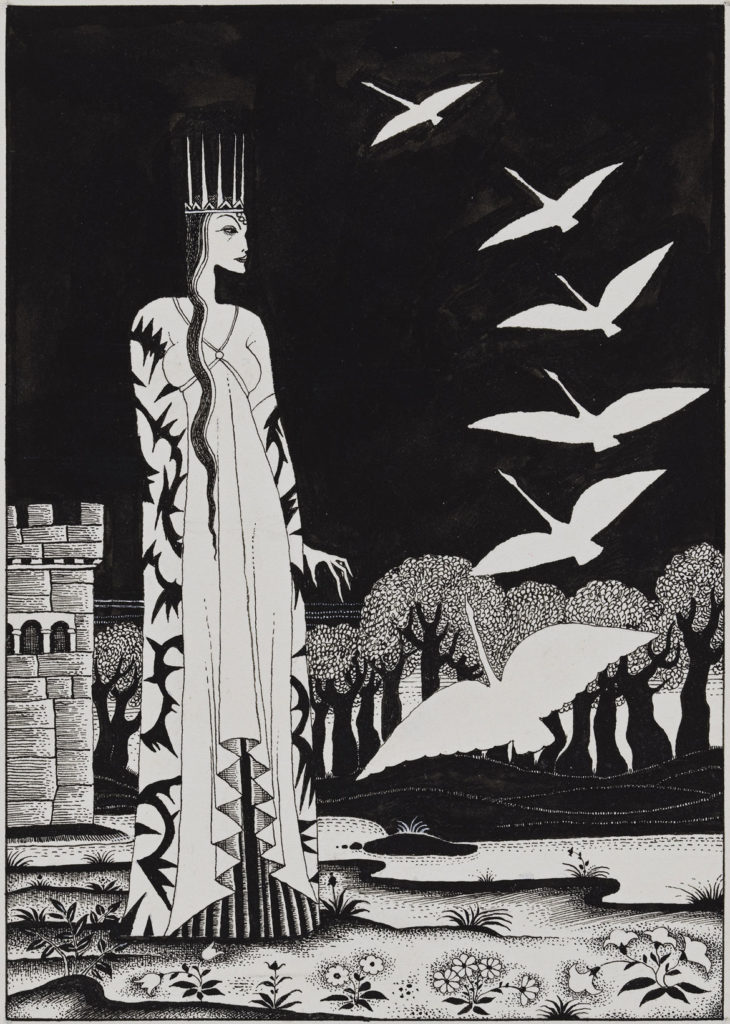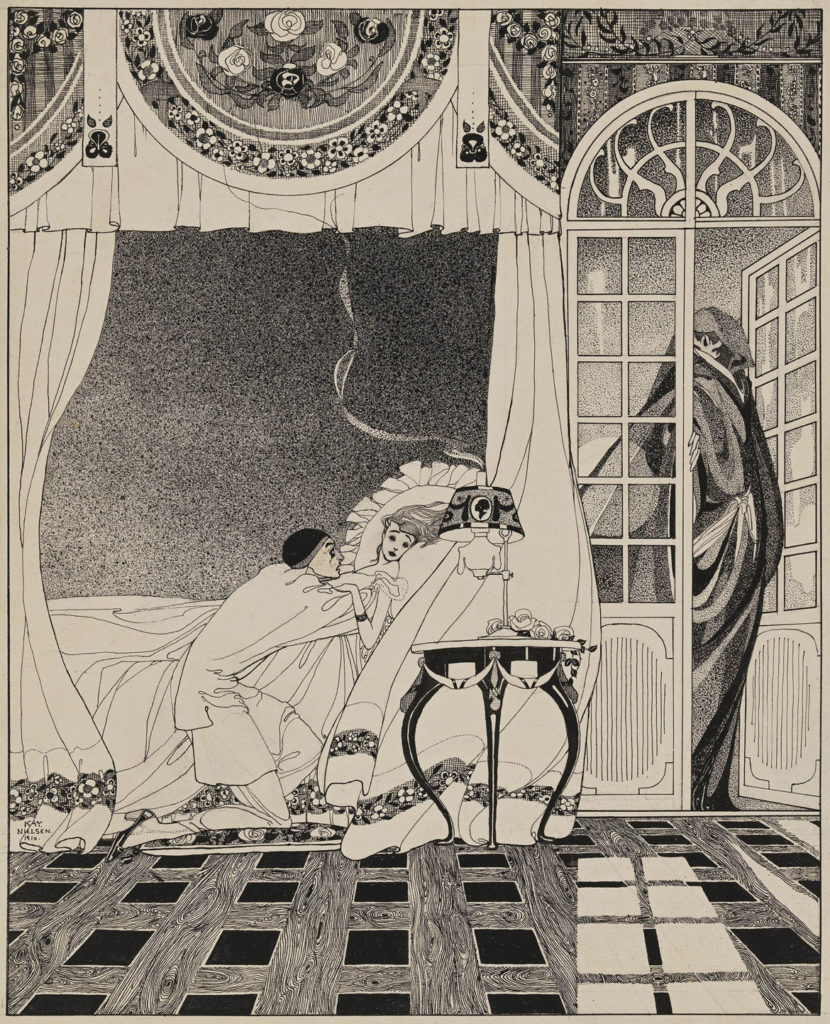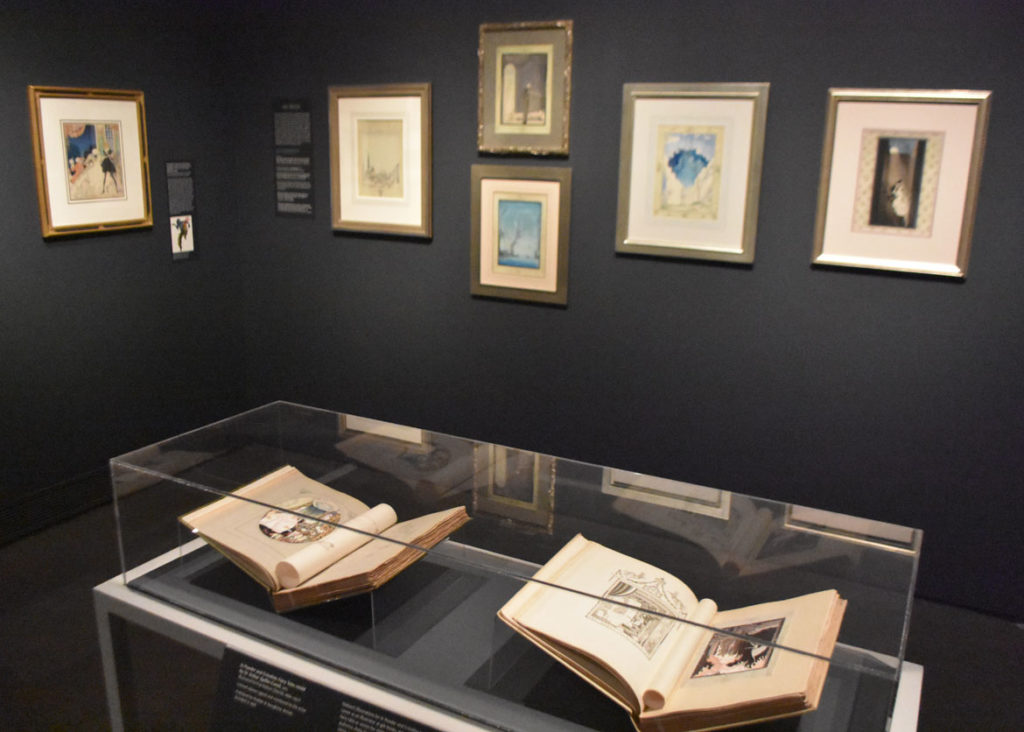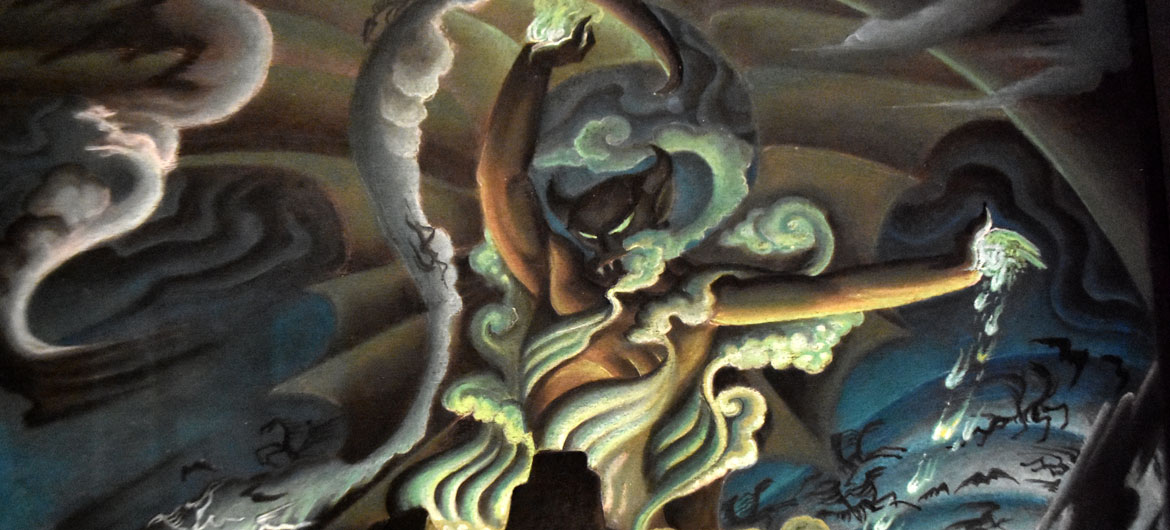The most famous creation of Kay Nielsen (1886-1957), one of the outstanding illustrators at the dawn of the 20th century, is the demon that steals the show at the end of Disney’s 1940 animated film “Fantasia.”
The character was famously brought to life by animator Bill Tytla, who closely followed Nielsen’s planning sketches of the glowing-eyed devil, his taut chest wreathed in smoke, flames dripping from his palms, orchestrating the bats and lesser demons that swirl about.
Nielsen—the subject of the exhibition “Kay Nielsen’s Enchanted Vision: The Kendra and Allan Daniel Collection” at Boston’s Museum of Fine Arts from July 20, 2019, to Jan. 20, 2020—had arrived in California in 1936 to design sets and costumes for plays. But work was hard to come by. Playwright Alice Kauser took his “Arabian Nights” drawings to Hollywood movie folks to try to drum up business.
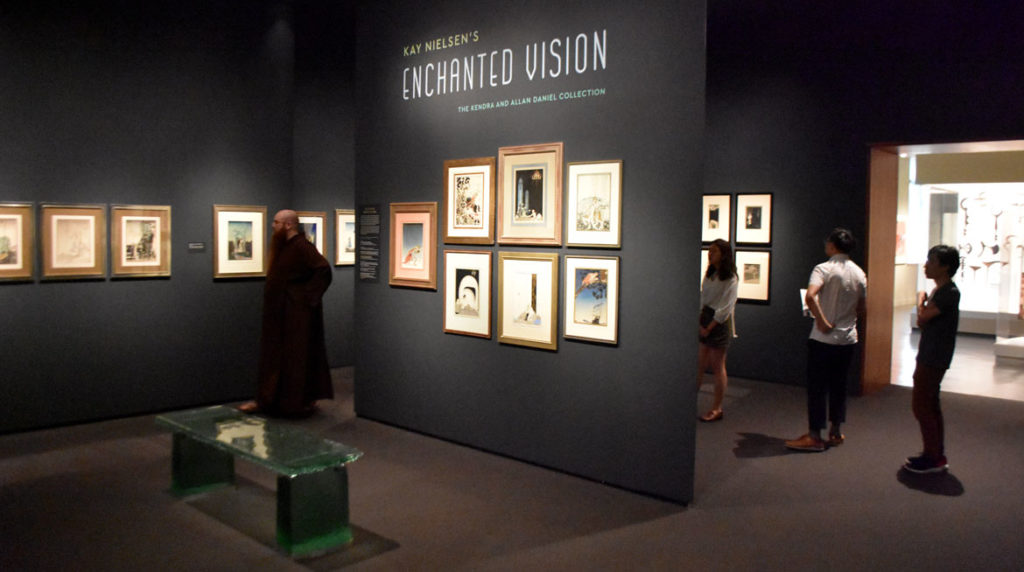
“I have now been here 15 months but Hollywood has not reacted,” he wrote her in November 1937.
Nielsen showed up with his portfolio at the Disney studio’s front door in late 1938. “Jesus, this guy’s great!” Joe Grant, who headed Disney’s Character Model Department, remembered in a 1994 interview with John Canemaker. The Disney studio newsletter The Bulletin described the artist as “internationally known as an illustrator of fine books” when it announced he had begun employment there on Jan. 9, 1939. His job? To help imagine Disney’s artistically ambitious classical music feature “Fantasia.”
Kay Nielsen was born in Copenhagen, Denmark, on March 12, 1886. His parents were actors. His father also directed, while his mother also sang. “In this tense atmosphere of art, I was brought up,” Nielsen wrote in a 1930 autobiographical sketch in “Contemporary Illustrators of Children’s Books,” as quoted in Didier Ghez’s 2016 book “They Drew As They Pleased: The Hidden Art of Disney’s Musical Years” (the source of much of my information about his time at Disney). “I never really intended to be an artist myself.”
But Nielsen studied art in Paris, then moved to London, where in 1912, he had his first gallery exhibition. This led to commissions to illustrate books, beginning with a 1913 compilation of French fairytales, retold by Sir Arthur Quiller-Couch, titled “In Powder and Crinoline” (called “The Twelve Dancing Princesses” in the United States).
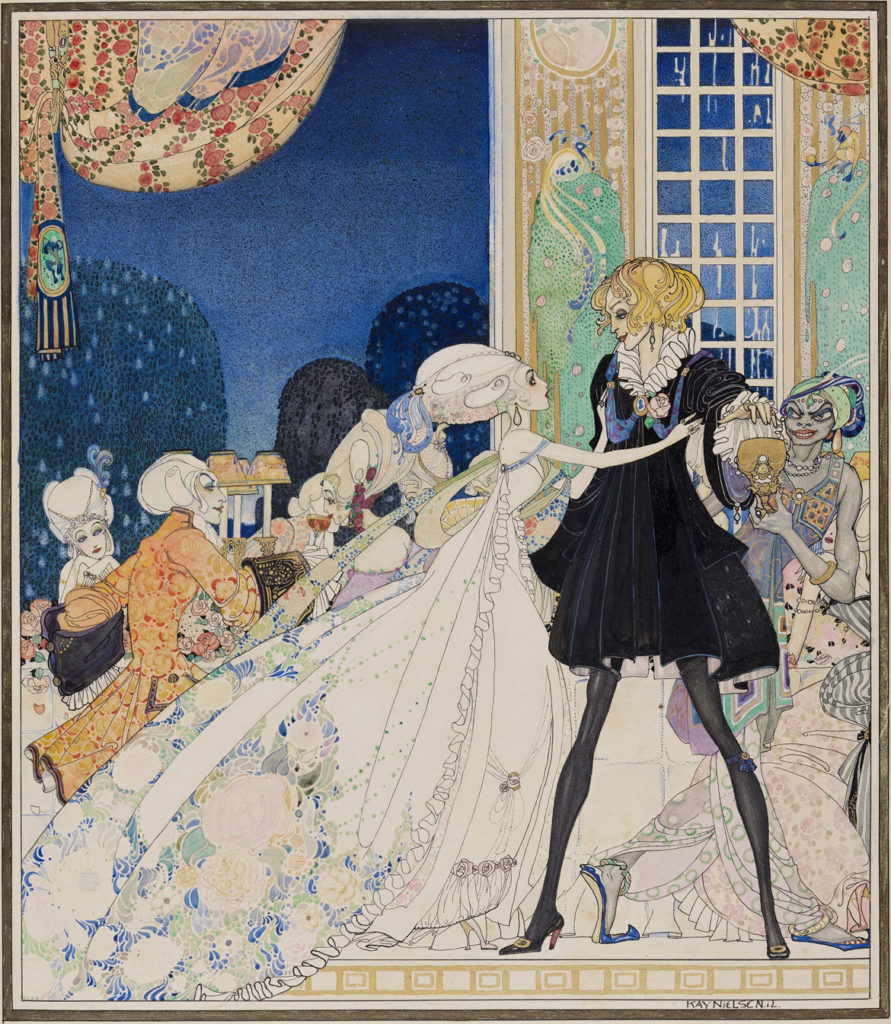

“Exquisitely done,” according to a December 1923 review in The New York Times. “He has clad his slender, graceful ladies in ballooning skirts and flowing, voluminous folds with surprisingly charming results. Surely no one ever guessed before how much rhythmic grace, how much beauty of undulating line could be captured from those swaying, bulging habiliments.”
Nielsen’s next project was his 1914 book “East of the Sun and West of the Moon,” illustrating Norwegian tales collected by folklorists Peter Christen Asbjørnsen and Jørgen Engebretsen Moe in the mid 1800s. It offers stories of three billy-goats gruff, of a woman who must marry a giant snake, of a princess who invites a gardener to sleep on her bedroom floor, of three princesses buried up to their necks by trolls and the only way to save them, they tell a wandering prince, is for the prince to allow himself to be whipped by the trolls.
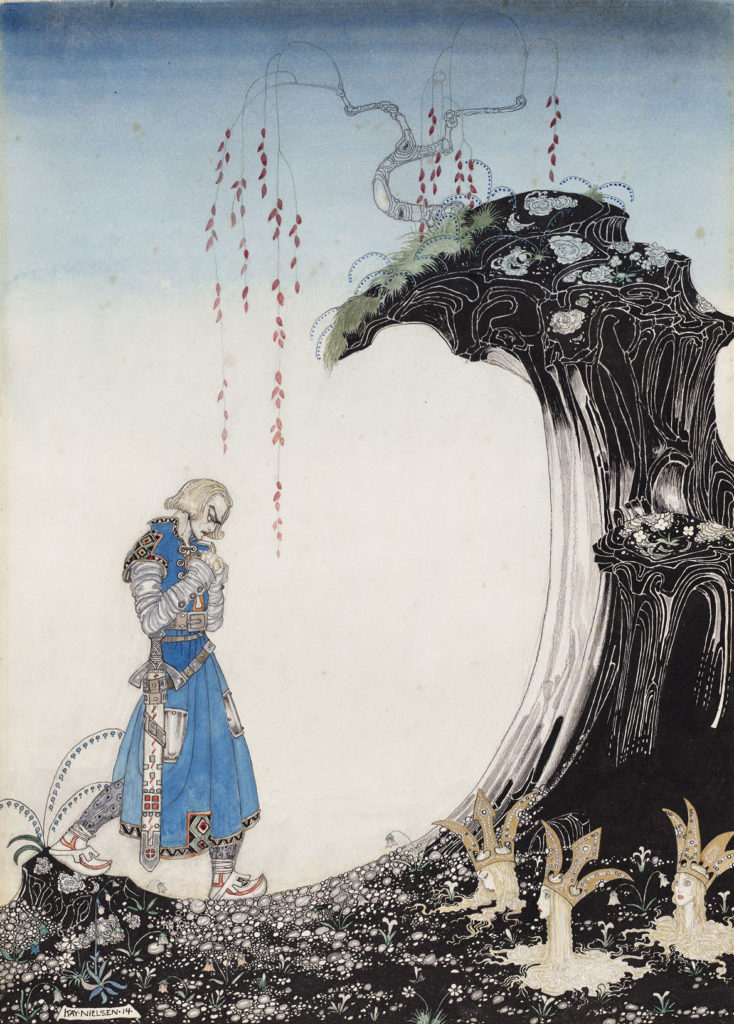
These weren’t picture books as they overflow from library children’s rooms today, but storybooks with lots of words and then an occasional full-page illustration that opens like a window into a dazzling other world.
“One of the finest collections of fairy tales ever published,” Alison Lurie wrote in The New York Times in 1977, “full of enchanted princes and long-nosed trolls and magical journeys, brilliantly portrayed in the stylized Art Deco paintings of the Danish artist Kay Nielsen.”

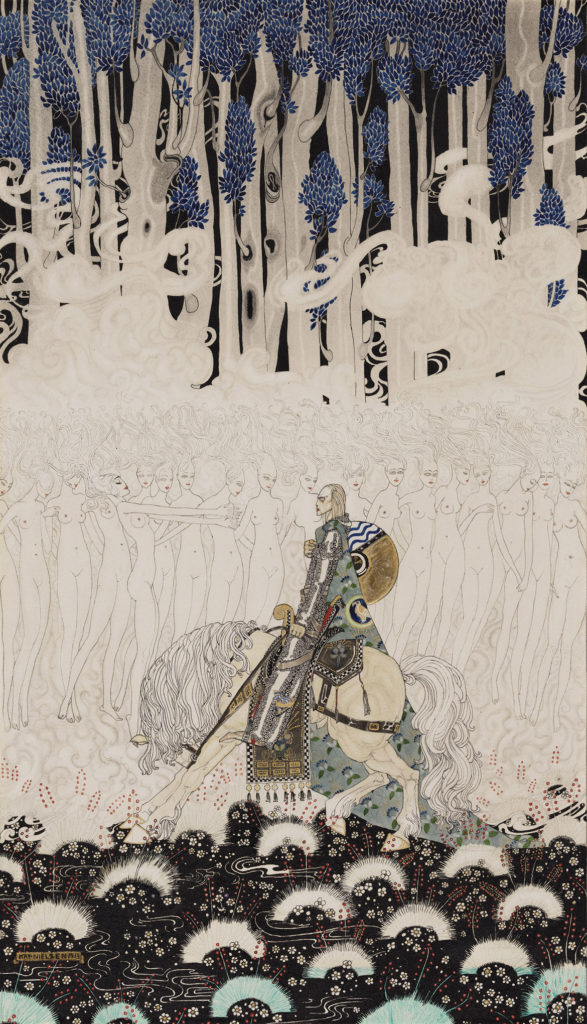
transparent and opaque watercolor, pen and brush and ink, gesso and metallic paint, over graphite. (Courtesy Museum of Fine Arts, Boston)
Nielsen’s illustrations are romantic, sexy, depicting delicate princesses and willowy bad boys lurking in parks or lounging alongside ladies’ beds or occasionally straddling warhorses. His art is flat and graphic, lavishly stylized and delicate, with bold silhouettes decorated with filigrees of fine lines. He took inspiration from the traditional art of Persia, India, China. His works bring to mind fashion sketches, the English illustrator Aubrey Beardsley, and the tableaus of modernist ballets—like Vaslav Nijinsky’s 1912 “The Afternoon of a Faun” for the Ballets Russes. (Nielsen saw the company dance while a student in Paris.) Nielsen’s artworks are hand-drawn and painted with such precision that you might suspect they appeared by magic.
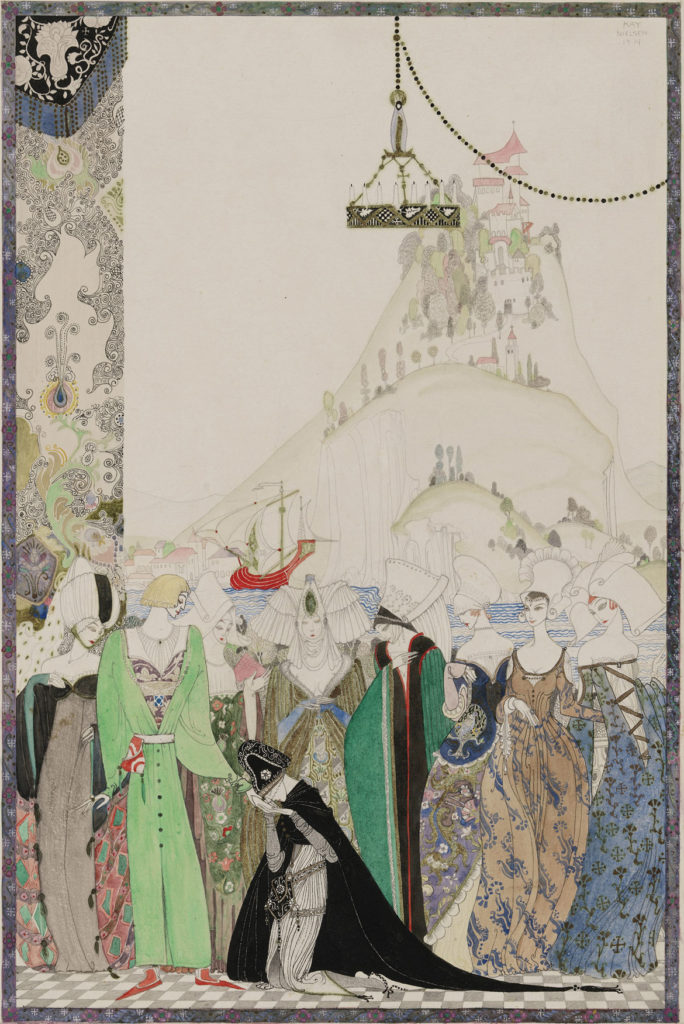
Then the First World War intervened. As the luxury book market crashed, Nielsen returned to Copenhagen to design costumes and stage sets for productions of Shakespeare’s ‘The Tempest,” Danish playwright Adam Oehlenschläger’s “Aladdin,” Jean Sibelius’s “Scaramouche.” His 1917 drawings for set and costumes for “Alladin,” as well as images of a Hindu dancer and Chinese fiddler, were highlighted in “The International Exhibition of Theatre Art” at New York’s Museum of Modern Art in 1934.
Nielsen continued to work on illustrations. He painted watercolors for a Danish translation of “1001 Nights” that wasn’t published due to the war. (He kept them in a wooden box that was still in his house after he and his wife died in the 1950s. They were finally published for the first time by Taschen last fall.)
“Something emerges that belongs to no one else than Kay Nielsen himself, a little aromatic spirit of Scandinavia that persists through the intense sophistication of manner and form,” The New York Times wrote of a December 1917 exhibition of his watercolors. “There is a poignant wistfulness in his porcelain shepherdess sprinkled with minute ornament; in his fairy-tale ‘Lassie’ taken home on a magical horse with braided tail and mane, the long train of her gown curling about her slender huddled limbs like a winding sheet; in his Princess Diaphanie, so frail that the lightest puff of a mischievous breeze blows her away from entreating love; in the Prunella of the last act with dying Pierrot at her feet; in her crouching figure on the flowered knoll against the wonderfully beautiful background of ‘The Thick Wood.’”
“There are three war pictures in the exhibition,” the article noted, “curiously attenuated moans of horror, deliberately arranged, but not without effectiveness in which color is asked to bear the burden of the message.”
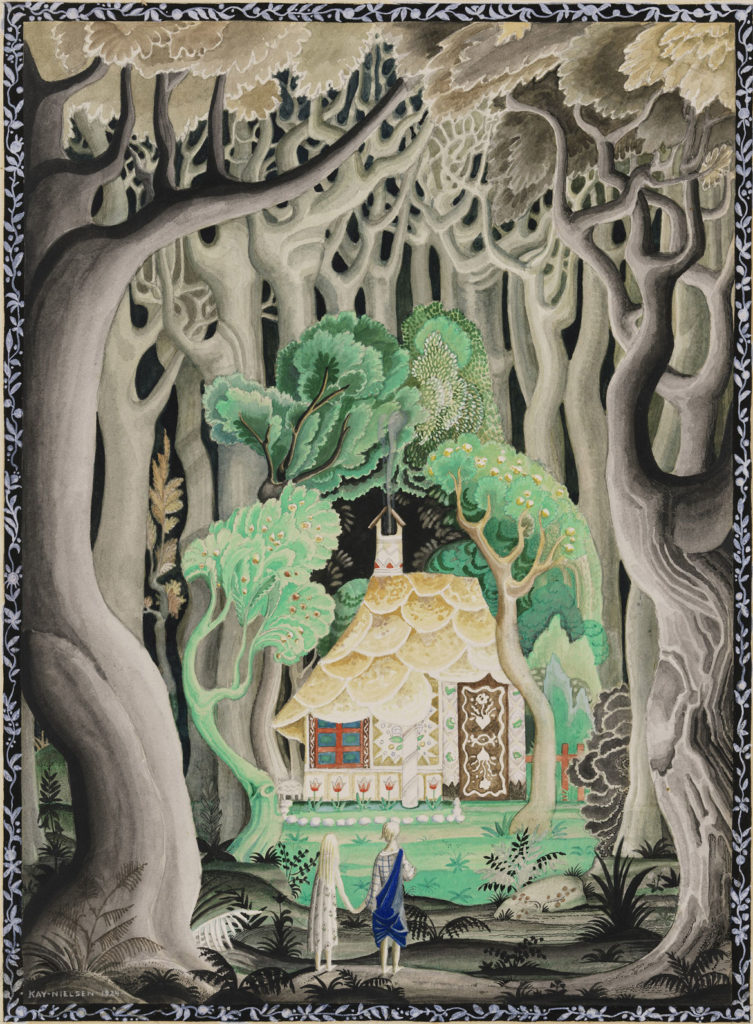
Nielsen’s first book after the war was “Fairy Tales by Hans Andersen,” published in 1924, which included some illustrations that dated back to his Paris student days. He followed that with “Hansel and Gretel and Other Stories by the Brothers Grimm” in 1925. In one iconic scene, Nielsen depicts Hansel and Gretel holding hands, as if comforting each other, as they stand dwarfed by a dead gray tangle of forest. But in the center, like an oasis, or a mirage, a copse of green trees bloom that shade a cottage made of sweets.
Nielsen’s next and last book was “Red Magic: A Collection of the World’s Best Fairy Tales from All Countries,” published as a cheap, small version at the start of the Depression in 1930.
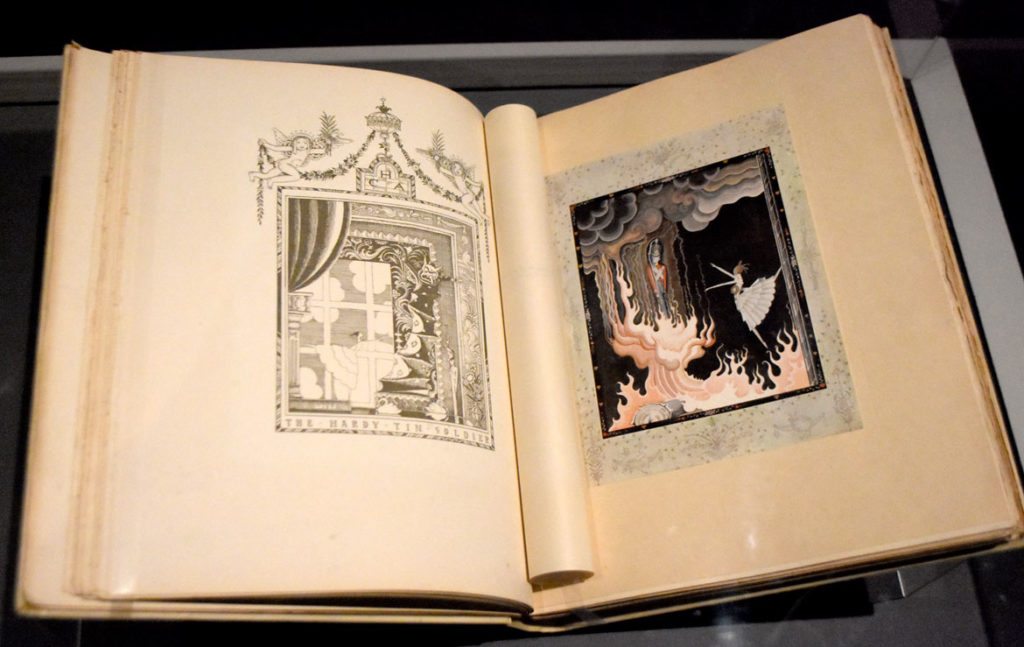
Nielsen arrived in New York aboard the SS Europa on Aug. 7, 1936, and headed for Los Angeles to work in theater and, hopefully, Hollywood. When he joined Disney to make story planning sketches to inspire the animators in 1939, he negotiated for the studio to help him get U.S. government permission to move his wife Ulla from Denmark to California. She made it to the United States that November, two months after Hitler’s Germany invaded Poland.
Nielsen was one of the last of a group of European immigrant artists hired by the Disney studio to give their groundbreaking feature-length animated films like “Snow White and the Seven Dwarfs” (1937) and “Pinocchio” (1940) the atmosphere of villages in the European Alps and an “Old World” artistic richness. Among them were Gustaf Tenggren, Ferdinand Horvath, Albert Hunter and Sylvia Holland. (After World War II, Disney films would turn more American—modern, streamlined, Victorian, suburban.)
World War II now hurt the market for Disney’s animations. “Fantasia,” released in November 1940, was a financial flop. As Disney looked to cut costs and increase efficiency, Nielsen struggled with the pace demanded. “Everything that man did was great,” Disney colleague Campbell Grant recalled in 1977 interview, as quoted in Didier Ghez’s 2016 book “They Drew As They Pleased.” “But you couldn’t hurry him. He just worked at his own speed, and if the efficiency expert came around and tried to bug him, he just wouldn’t talk to him.”
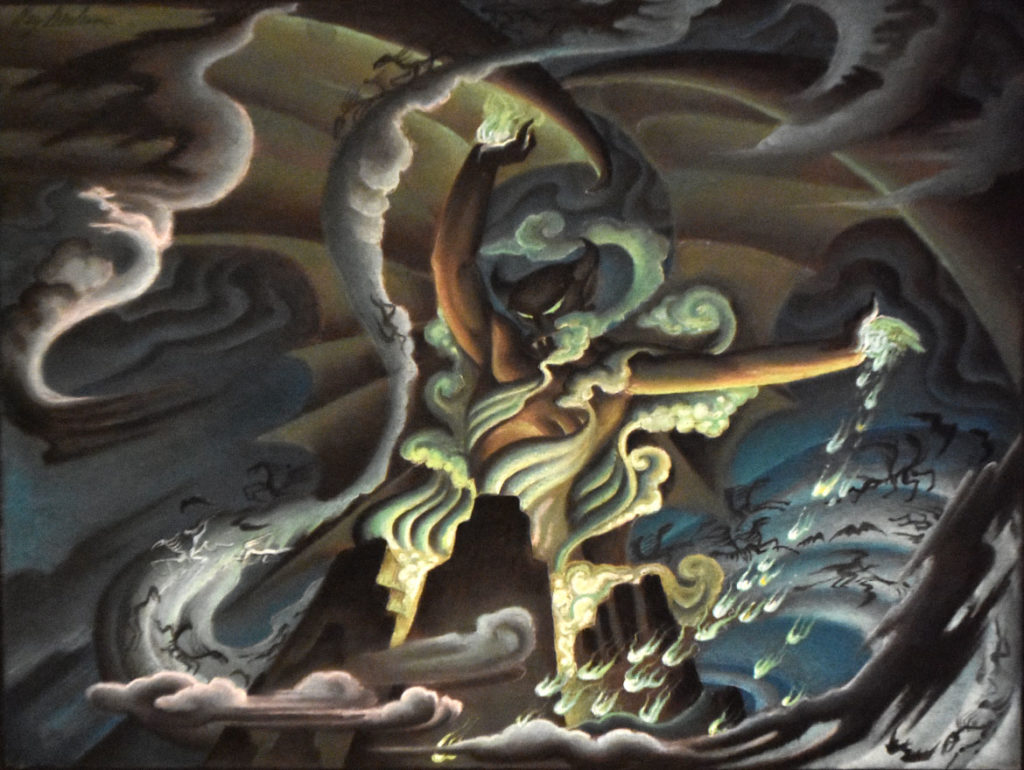
The studio laid Nielsen off in June 1940, only to rehire him at the end of that September to do planning artwork for “Alice in Wonderland” and “Penelope.” But both projects were soon postponed until after the war. He was asked to develop storyboards for Wagner’s “The Ride of the Valkyries,” expected to become part of a new version of “Fantasia,” but which was abandoned. He also worked on an adaptation of Hans Christian Andersen’s “The Little Mermaid,” which was shelved until 1989.
“I have been very nervous and uncertain regarding everything here at the Studio, working away, but knowing nothing,” Nielsen wrote to his friend, playwright Zoe Akins, on Dec. 22, 1940. “I stay scared. I can’t help it.”
The following May 23, just days before Disney animators went on strike on May 29, Nielsen was out of work again. “Kay is only working at Disney this week, then he is out,” Ulla wrote Akins in May 1942. “Walt told him yesterday, just before he left.”
Nielsen’s on-again-off-again relationship with Disney was just the start of his financial troubles. He painted some murals for Los Angeles schools between 1942 and ’46, and exhibited his art in the Children’s Room at the New York Public Library. Nielsen and his wife moved back to Denmark from 1949 to ’51. He was employed again at Disney, working on “Sleeping Beauty,” from late 1952 to April 1953. By some accounts, he tried to make money raising chickens. But all the accounts agree that Nielsen died in poverty, his art much forgotten, on June 21, 1957.
If this is the kind of coverage of arts, cultures and activisms you appreciate, please support Wonderland by contributing to Wonderland on Patreon. And sign up for our free, weekly newsletter so that you don’t miss any of our reporting.
